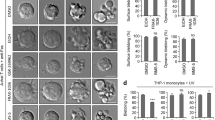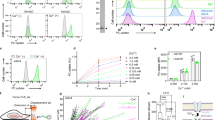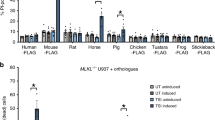Abstract
Increased phosphorylation of myosin light chain (MLC) is necessary for the dynamic membrane blebbing that is observed at the onset of apoptosis. Here we identify ROCK I, an effector of the small GTPase Rho, as a new substrate for caspases. ROCK I is cleaved by caspase-3 at a conserved DETD1113/G sequence and its carboxy-terminal inhibitory domain is removed, resulting in deregulated and constitutive kinase activity. ROCK proteins are known to regulate MLC-phosphorylation, and apoptotic cells exhibit a gradual increase in levels of phosphorylated MLC concomitant with ROCK I cleavage. This phosphorylation, as well as membrane blebbing, is abrogated by inhibition of caspases or ROCK proteins, but both processes are independent of Rho activity. We also show that expression of active truncated ROCK I induces cell blebbing. Thus, activation of ROCK I by caspase-3 seems to be responsible for bleb formation in apoptotic cells.
This is a preview of subscription content, access via your institution
Access options
Subscribe to this journal
Receive 12 print issues and online access
$209.00 per year
only $17.42 per issue
Buy this article
- Purchase on Springer Link
- Instant access to full article PDF
Prices may be subject to local taxes which are calculated during checkout








Similar content being viewed by others
References
Rao, L., Perez, D. & White, E. Lamin proteolysis facilitates nuclear events during apoptosis. J. Cell. Biol. 135, 1441–1455 (1996).
Enari, M. et al. A caspase-activated DNase that degrades DNA during apoptosis, and its inhibitor ICAD. Nature 391, 43–50 (1998) (published erratum Nature 393, 396).
Liu, X., Zou, H., Slaughter, C. & Wang, X. DFF, a heterodimeric protein that functions downstream of caspase-3 to trigger DNA fragmentation during apoptosis. Cell 89, 175–184 (1997).
Rudel, T. & Bokoch, G. M. Membrane and morphological changes in apoptotic cells regulated by caspase-mediated activation of PAK2. Science 276, 1571–1574 (1997).
Lee, N. et al. Activation of hPAK65 by caspase cleavage induces some of the morphological and biochemical changes of apoptosis. Proc. Natl Acad. Sci. USA 94, 13642–13647 (1997).
Rudolf, E., Peychl, J., Novak, J. & Cervinka, M. Apoptosis — when the cells begin to dance. Front. Biosci. 5, F1–F2 (2000).
Kerr, J. F., Winterford, C. M. & Harmon, B. V. Apoptosis. Its significance in cancer and cancer therapy. Cancer 73, 2013–2026 (1994) (published erratum Cancer 73, 3108).
Majno, G. & Joris, I. Apoptosis, oncosis, and necrosis. An overview of cell death. Am. J. Pathol. 146, 3–15 (1995).
Zheng, T. S. et al. Caspase-3 controls both cytoplasmic and nuclear events associated with Fas-mediated apoptosis in vivo. Proc. Natl Acad. Sci. USA 95, 13618–13623 (1998).
Janicke, R. U., Ng, P., Sprengart, M. L. & Porter, A. G. Caspase-3 is required for alpha-fodrin cleavage but dispensable for cleavage of other death substrates in apoptosis. J. Biol. Chem. 273, 15540–15545 (1998).
Laster, S. M. & Mackenzie, J. M. Jr Bleb formation and F-actin distribution during mitosis and tumor necrosis factor-induced apoptosis. Microsc. Res. Tech. 34, 272–280 (1996).
Mills, J. C., Stone, N. L., Erhardt, J. & Pittman, R. N. Apoptotic membrane blebbing is regulated by myosin light chain phosphorylation. J. Cell. Biol. 140, 627–636 (1998).
Huot, J. et al. SAPK2/p38-dependent F-actin reorganization regulates early membrane blebbing during stress-induced apoptosis. J. Cell. Biol. 143, 1361–1373 (1998).
Mills, J. C., Stone, N. L. & Pittman, R. N. Extranuclear apoptosis. The role of the cytoplasm in the execution phase. J. Cell. Biol. 146, 703–708 (1999).
Kohama, K., Ye, L. H., Hayakawa, K. & Okagaki, T. Myosin light chain kinase: an actin-binding protein that regulates an ATP-dependent interaction with myosin. Trends Pharmacol. Sci. 17, 284–287 (1996).
Alessi, D., MacDougall, L. K., Sola, M. M., Ikebe, M. & Cohen, P. The control of protein phosphatase-1 by targetting subunits. The major myosin phosphatase in avian smooth muscle is a novel form of protein phosphatase-1. Eur. J. Biochem. 210, 1023–1035 (1992).
Amano, M. et al. Phosphorylation and activation of myosin by Rho-associated kinase (Rho–kinase). J. Biol. Chem. 271, 20246–20249 (1996).
Kimura, K. et al. Regulation of myosin phosphatase by Rho and Rho-associated kinase (Rho–kinase). Science 273, 245–248 (1996).
Kawano, Y. et al. Phosphorylation of myosin-binding subunit (MBS) of myosin phosphatase by Rho–kinase in vivo. J. Cell. Biol. 147, 1023–1038 (1999).
Ishizaki, T. et al. The small GTP-binding protein Rho binds to and activates a 160 kDa Ser/Thr protein kinase homologous to myotonic dystrophy kinase. EMBO J. 15, 1885–1893 (1996).
Leung, T., Manser, E., Tan, L. & Lim, L. A novel serine/threonine kinase binding the Ras-related RhoA GTPase which translocates the kinase to peripheral membranes. J. Biol. Chem. 270, 29051–29054 (1995).
Leung, T., Chen, X. Q., Manser, E. & Lim, L. The p160 RhoA-binding kinase ROK alpha is a member of a kinase family and is involved in the reorganization of the cytoskeleton. Mol. Cell. Biol. 16, 5313–5327 (1996).
Janicke, R. U., Sprengart, M. L., Wati, M. R. & Porter, A. G. Caspase-3 is required for DNA fragmentation and morphological changes associated with apoptosis. J. Biol. Chem. 273, 9357–9360 (1998).
Scaffidi, C., Krammer, P. H. & Peter, M. E. Isolation and analysis of components of CD95 (APO-1/Fas) death-inducing signaling complex. Methods 17, 287–291 (1999).
Ishizaki, T. et al. p160ROCK, a Rho-associated coiled-coil forming protein kinase, works downstream of Rho and induces focal adhesions. FEBS Lett. 404, 118–124 (1997).
Uehata, M. et al. Calcium sensitization of smooth muscle mediated by a Rho-associated protein kinase in hypertension. Nature 389, 990–994 (1997).
Itoh, K. et al. An essential part for Rho-associated kinase in the transcellular invasion of tumor cells. Nature Med. 5, 221–225 (1999).
Klages, B., Brandt, U., Simon, M. I., Schultz, G. & Offermanns, S. Activation of G12/G13 results in shape change and Rho/Rho–kinase-mediated myosin light chain phosphorylation in mouse platelets. J. Cell. Biol. 144, 745–754 (1999).
Essler, M., Staddon, J. M., Weber, P. C. & Aepfelbacher, M. Cyclic AMP blocks bacterial lipopolysaccharide-induced myosin light chain phosphorylation in endothelial cells through inhibition of Rho/Rho kinase signaling. J. Immunol. 164, 6543–6549 (2000).
Ishizaki, T. et al. Pharmacological properties of Y-27632, a specific inhibitor of rho-associated kinases. Mol. Pharmacol. 57, 976–983 (2000).
Sekine, A., Fujiwara, M. & Narumiya, S. Asparagine residue in the rho gene product is the modification site for botulinum ADP–ribosyltransferase. J. Biol. Chem. 264, 8602–8605 (1989).
Ridley, A. J. & Hall, A. The small GTP-binding protein rho regulates the assembly of focal adhesions and actin stress fibers in response to growth factors. Cell 70, 389–399 (1992).
Nagahara, H. et al. Transduction of full-length TAT fusion proteins into mammalian cells: TAT-p27Kip1 induces cell migration. Nature Med. 4, 1449–1452 (1998).
Hirose, M. et al. Molecular dissection of the Rho-associated protein kinase (p160ROCK)-regulated neurite remodeling in neuroblastoma N1E-115 cells. J. Cell. Biol. 141, 1625–1636 (1998).
Hall, A. Rho GTPases and the actin cytoskeleton. Science 279, 509–514 (1998).
McCarthy, N. J., Whyte, M. K., Gilbert, C. S. & Evan, G. I. Inhibition of Ced-3/ICE-related proteases does not prevent cell death induced by oncogenes, DNA damage, or the Bcl-2 homologue Bak. J. Cell. Biol. 136, 215–227 (1997).
Katoh, H. et al. Constitutively active α12, Gα13, and Gαq induce Rho-dependent neurite retraction through different signaling pathways. J. Biol. Chem. 273, 28700–28707 (1998).
Rao, J. Y. et al. Alterations of the actin polymerization status as an apoptotic morphological effector in HL-60 cells. J. Cell Biochem. 75, 686–697 (1999).
Ohashi, K. et al. Rho-associated kinase ROCK activates LIM-kinase 1 by phosphorylation at threonine 508 within the activation loop. J. Biol. Chem. 275, 3577–35782 (2000).
Ratcliffe, M. J., Smales, C. & Staddon, J. M. Dephosphorylation of the catenins p120 and p100 in endothelial cells in response to inflammatory stimuli. Biochem. J. 338, 471–478 (1999).
Zapata, J. M., Takahashi, R., Salvesen, G. S. & Reed, J. C. Granzyme release and caspase activation in activated human T-lymphocytes. J. Biol. Chem. 273, 6916–6920 (1998).
Chardin, P. et al. The mammalian G protein rhoC is ADP-ribosylated by Clostridium botulinum exoenzyme C3 and affects actin microfilaments in Vero cells. EMBO J. 8, 1087–1092 (1989).
Lang, P. et al. Characterization of a monoclonal antibody specific for the Ras-related GTP-binding protein Rho A. Biochem. Biophys. Res. Commun. 196, 1522–1528 (1993).
Acknowledgements
We thank J. Zugaza for comments and suggestions. This work was supported by INSERM and by grants from the Association pour la Recherche sur le Cancer. M.S. is supported by a fellowship from ARERS.
Author information
Authors and Affiliations
Corresponding author
Rights and permissions
About this article
Cite this article
Sebbagh, M., Renvoizé, C., Hamelin, J. et al. Caspase-3-mediated cleavage of ROCK I induces MLC phosphorylation and apoptotic membrane blebbing. Nat Cell Biol 3, 346–352 (2001). https://doi.org/10.1038/35070019
Received:
Revised:
Accepted:
Published:
Issue Date:
DOI: https://doi.org/10.1038/35070019
This article is cited by
-
Apoptotic bodies: bioactive treasure left behind by the dying cells with robust diagnostic and therapeutic application potentials
Journal of Nanobiotechnology (2023)
-
Stressed neuronal cells can recover from profound membrane blebbing, nuclear condensation and mitochondrial fragmentation, but not from cytochrome c release
Scientific Reports (2023)
-
Culture methods focusing on bile canalicular formation using primary human hepatocytes in a short time
In Vitro Cellular & Developmental Biology - Animal (2023)
-
Pleiotropic effects of cell competition between normal and transformed cells in mammalian cancers
Journal of Cancer Research and Clinical Oncology (2023)
-
Biological causes of immunogenic cancer cell death (ICD) and anti-tumor therapy; Combination of Oncolytic virus-based immunotherapy and CAR T-cell therapy for ICD induction
Cancer Cell International (2022)



